Charles E W Bean, Diaries, AWM38 3DRL 606/244/1 - 1916 - 1933 - Part 5
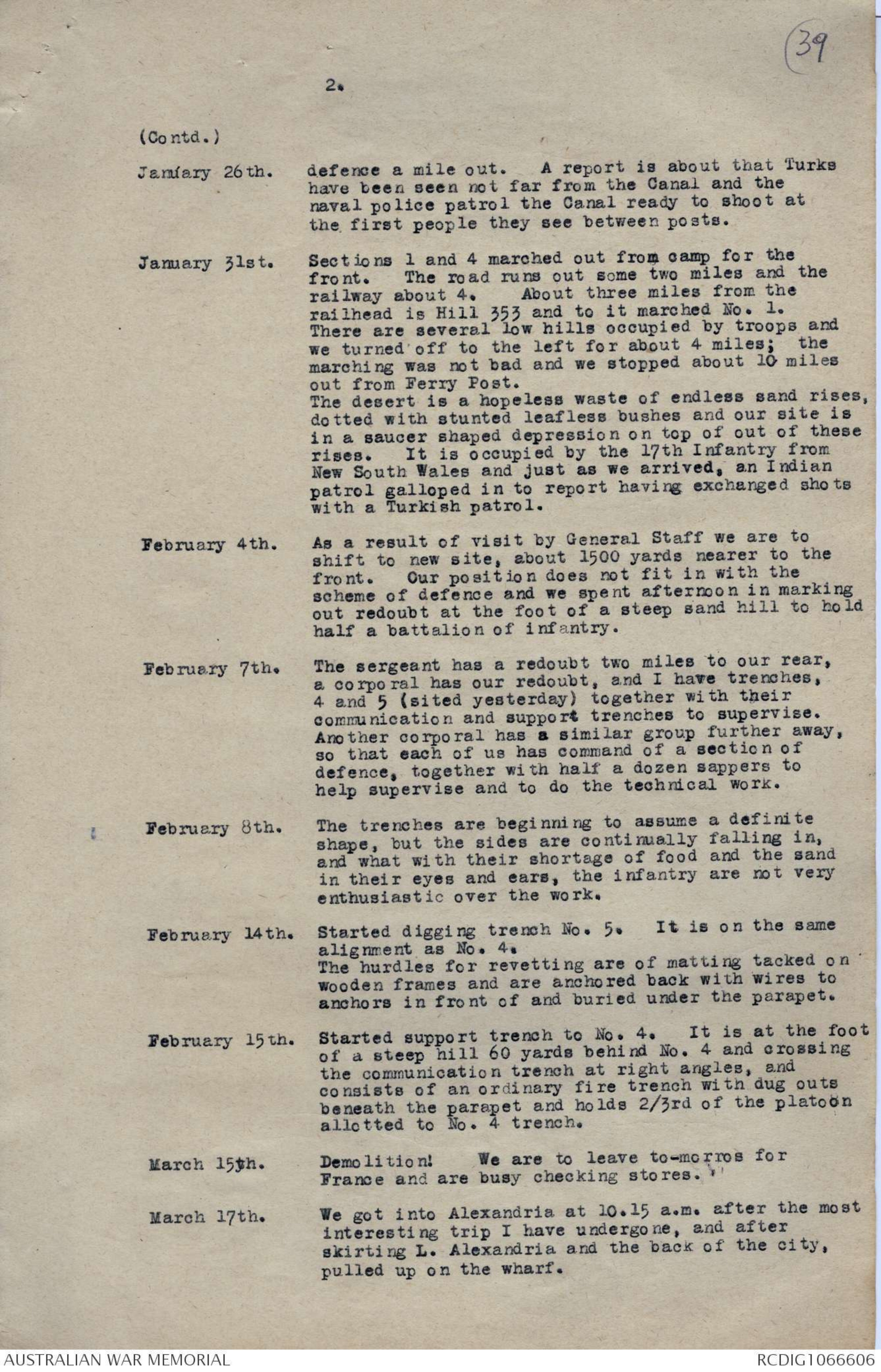
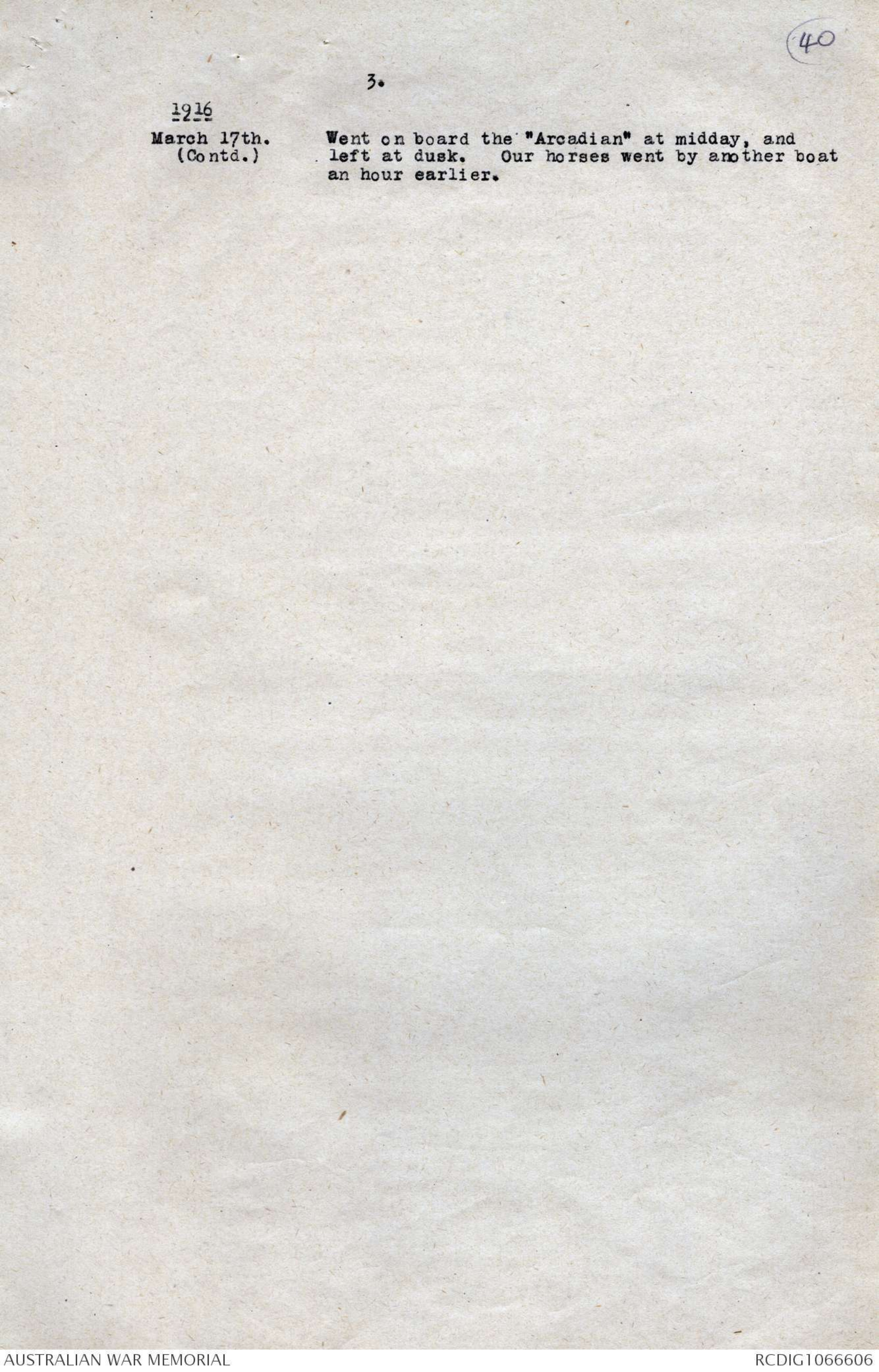
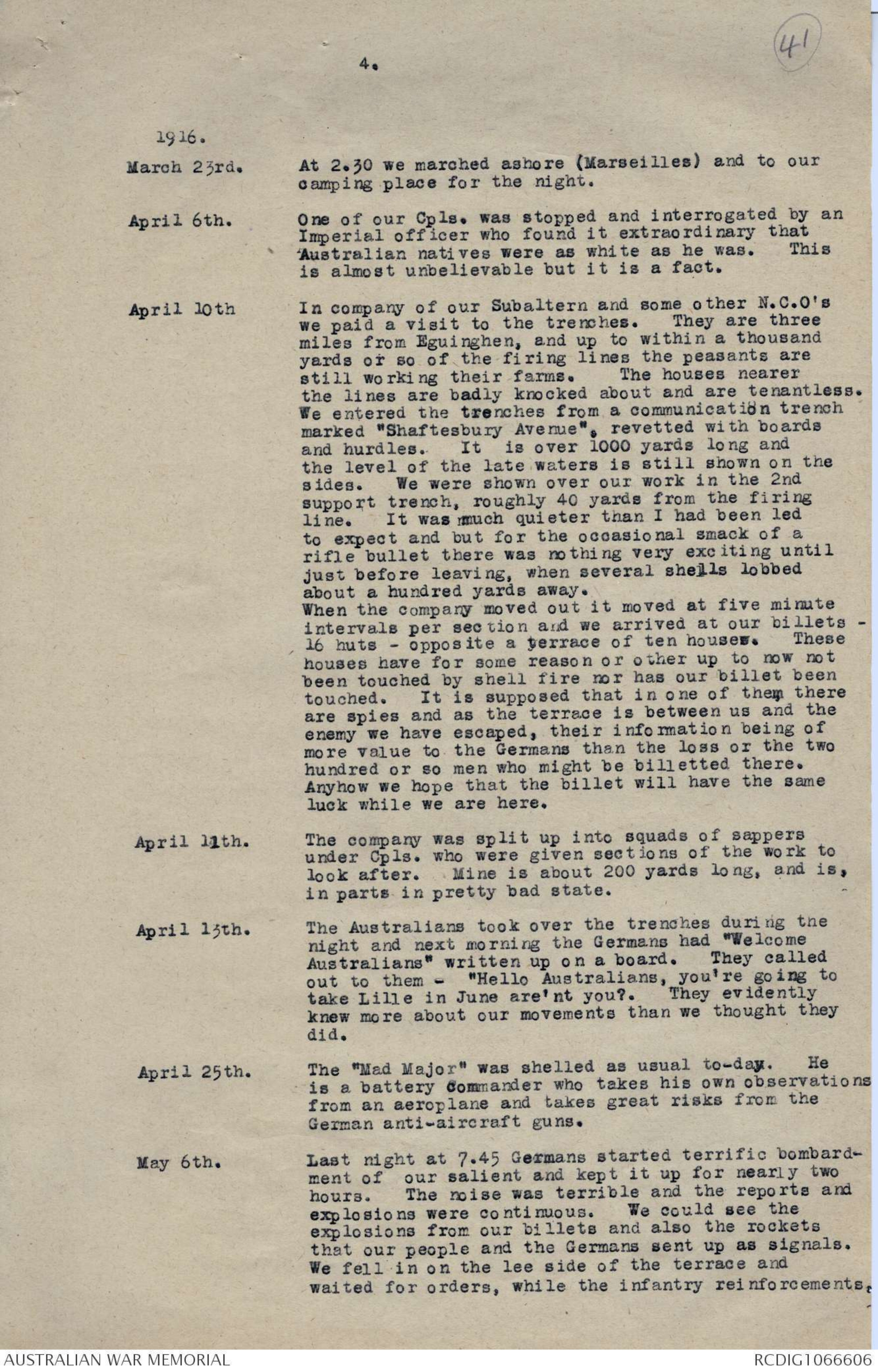

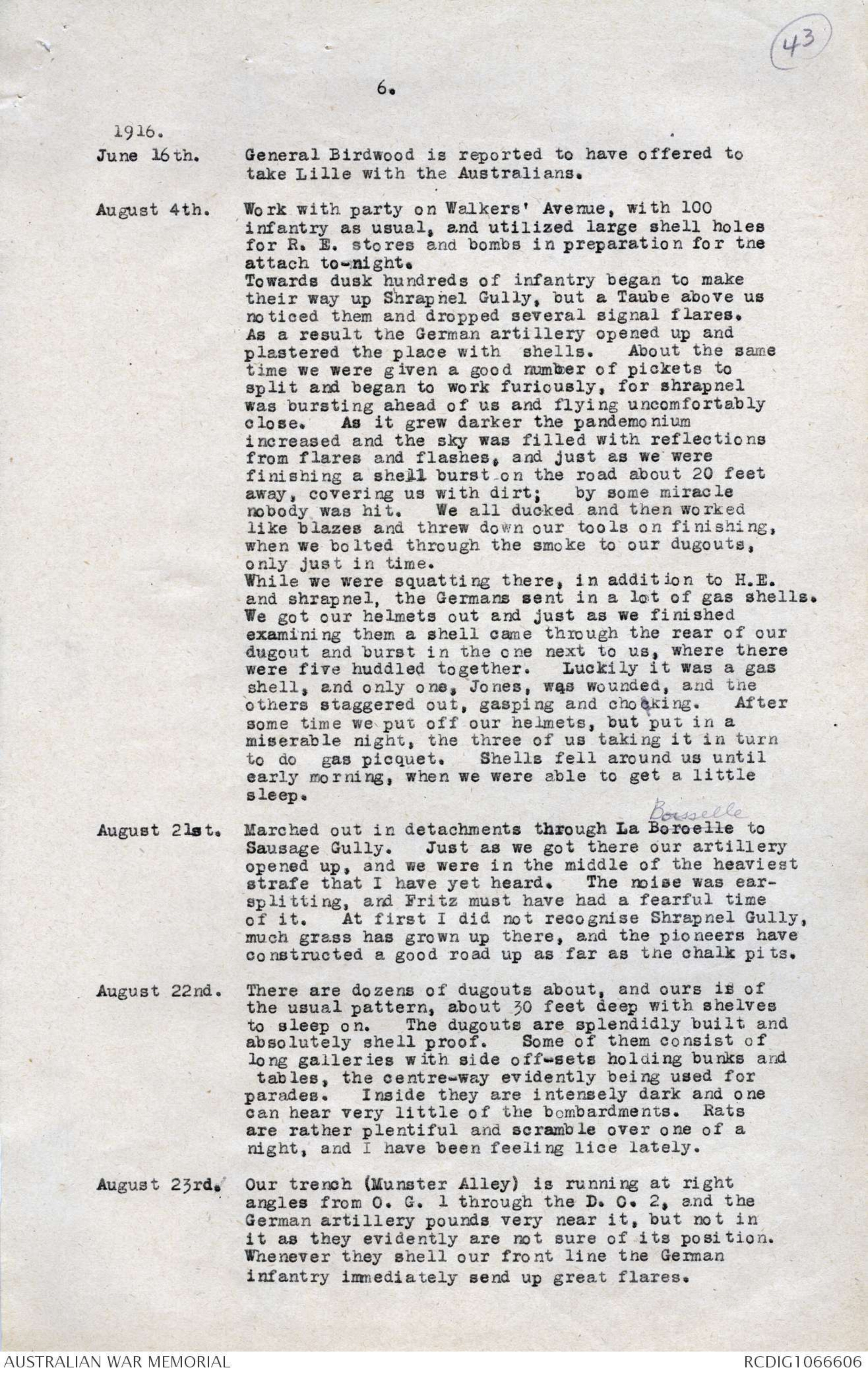

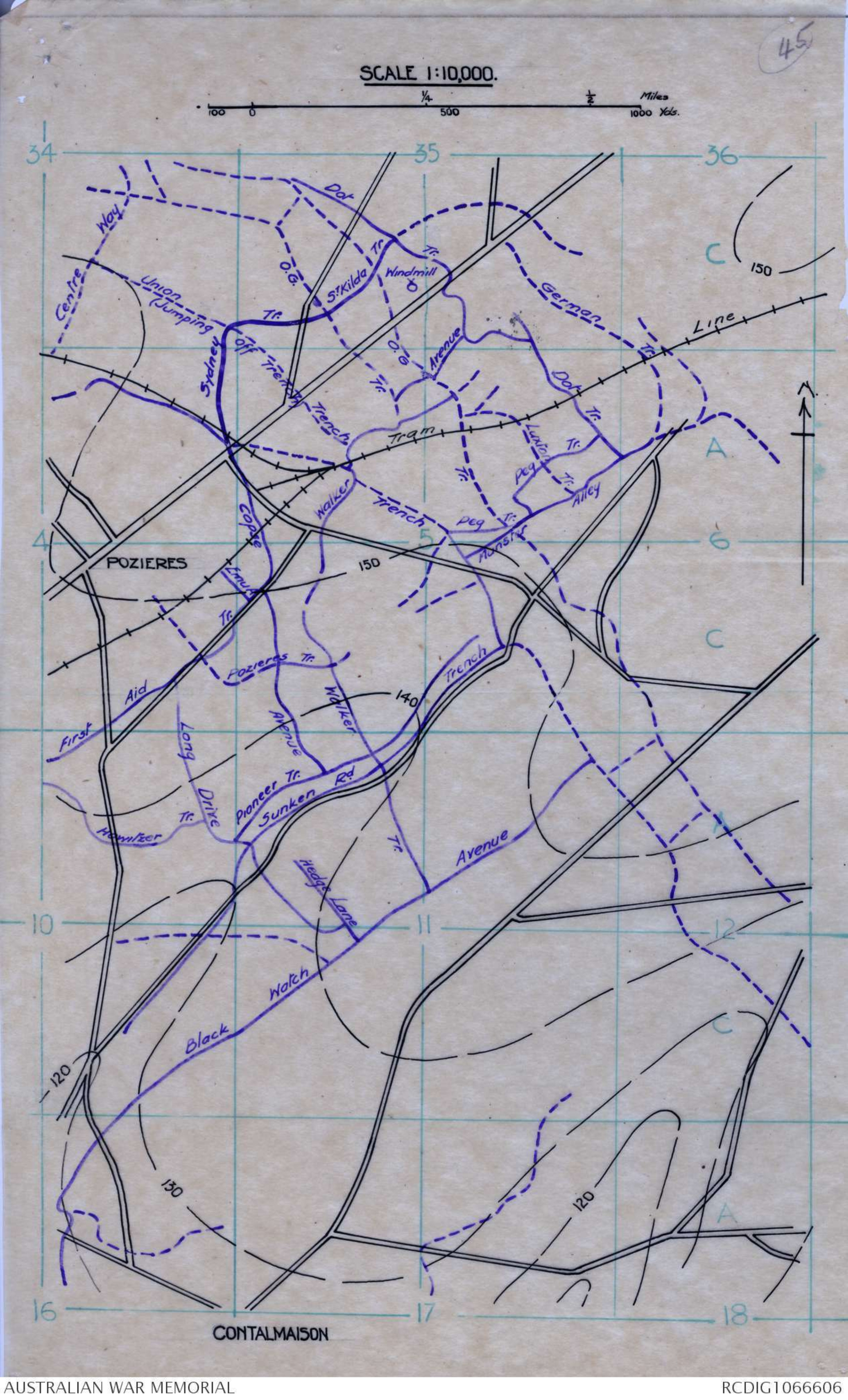
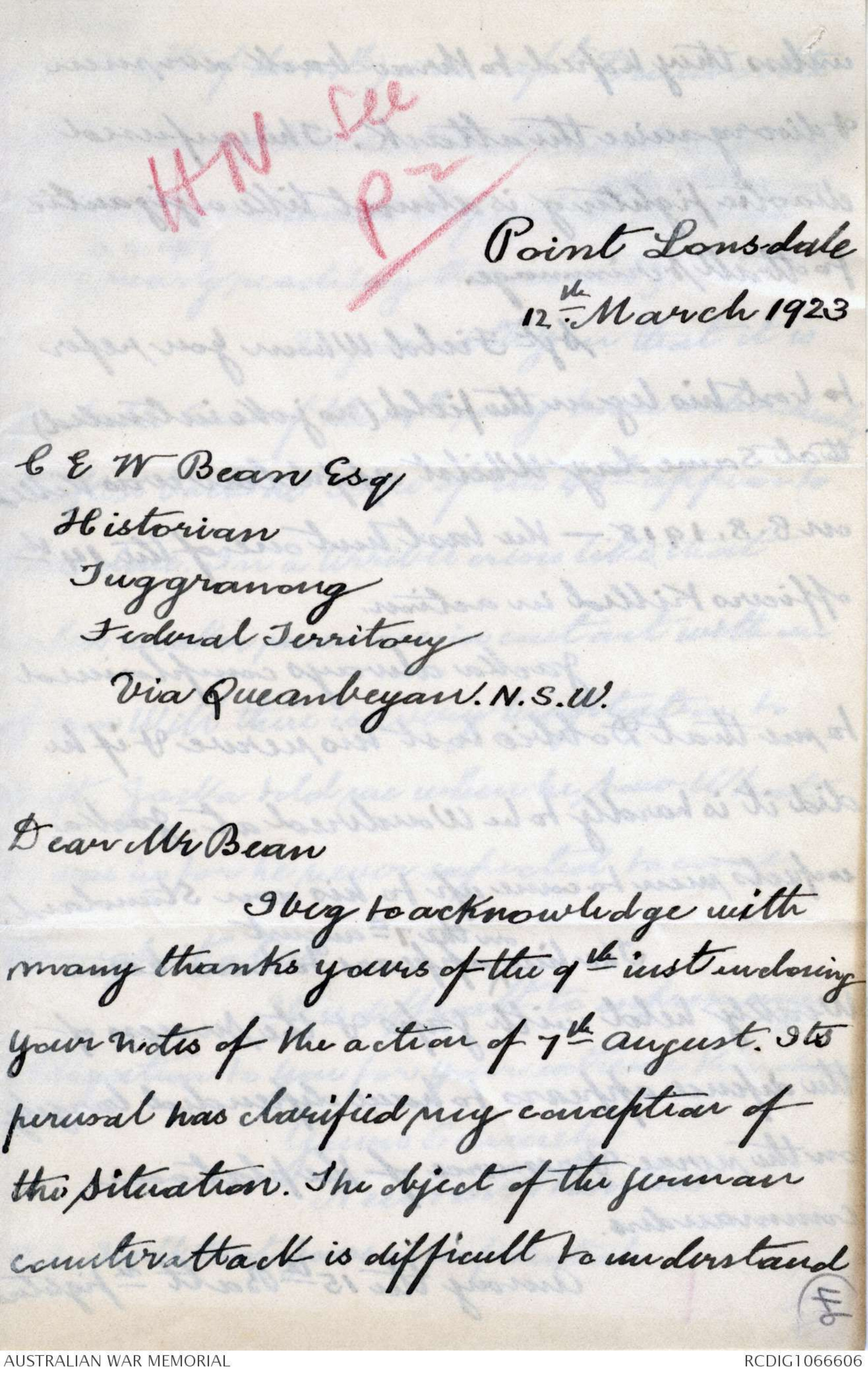
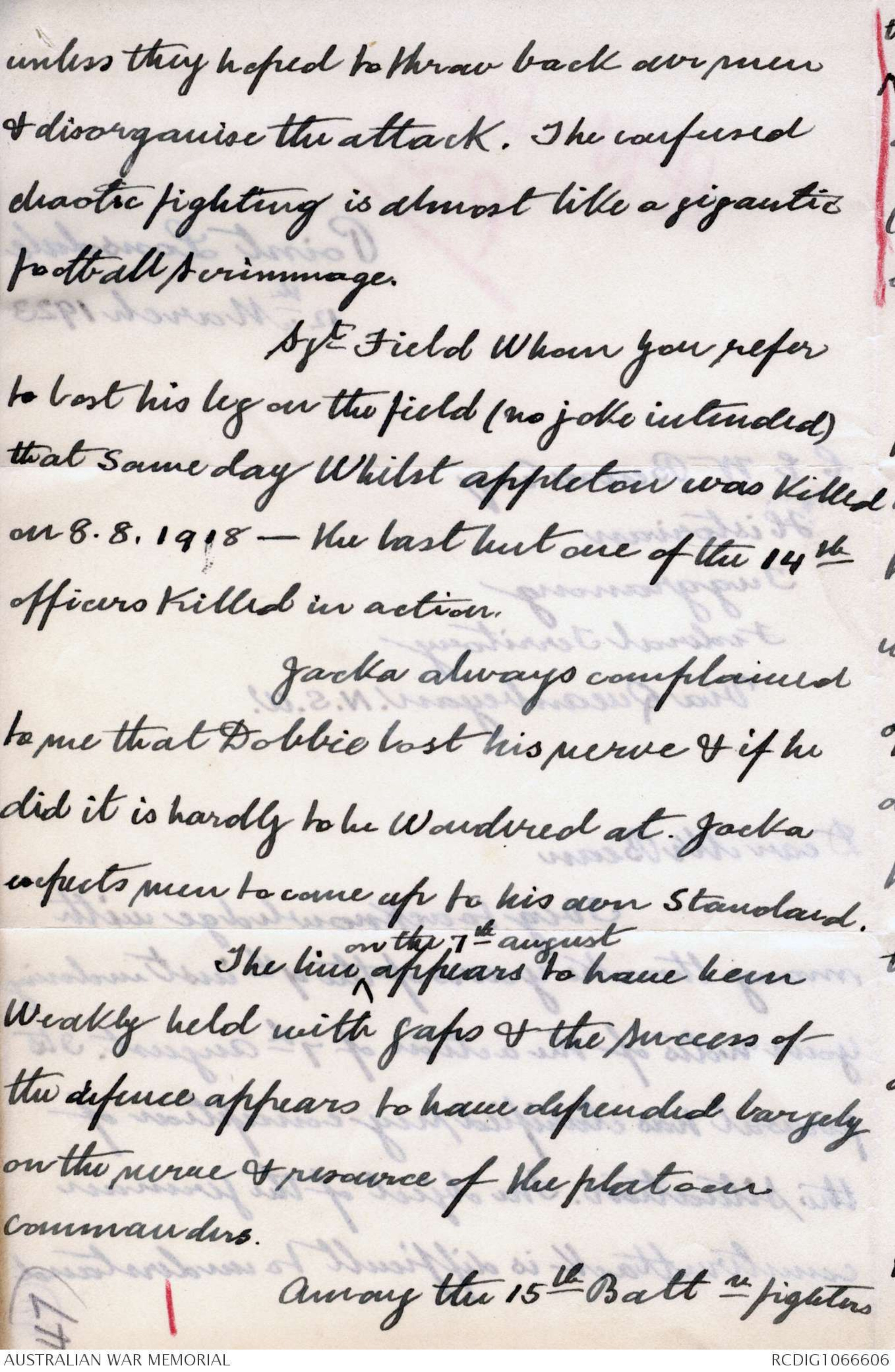
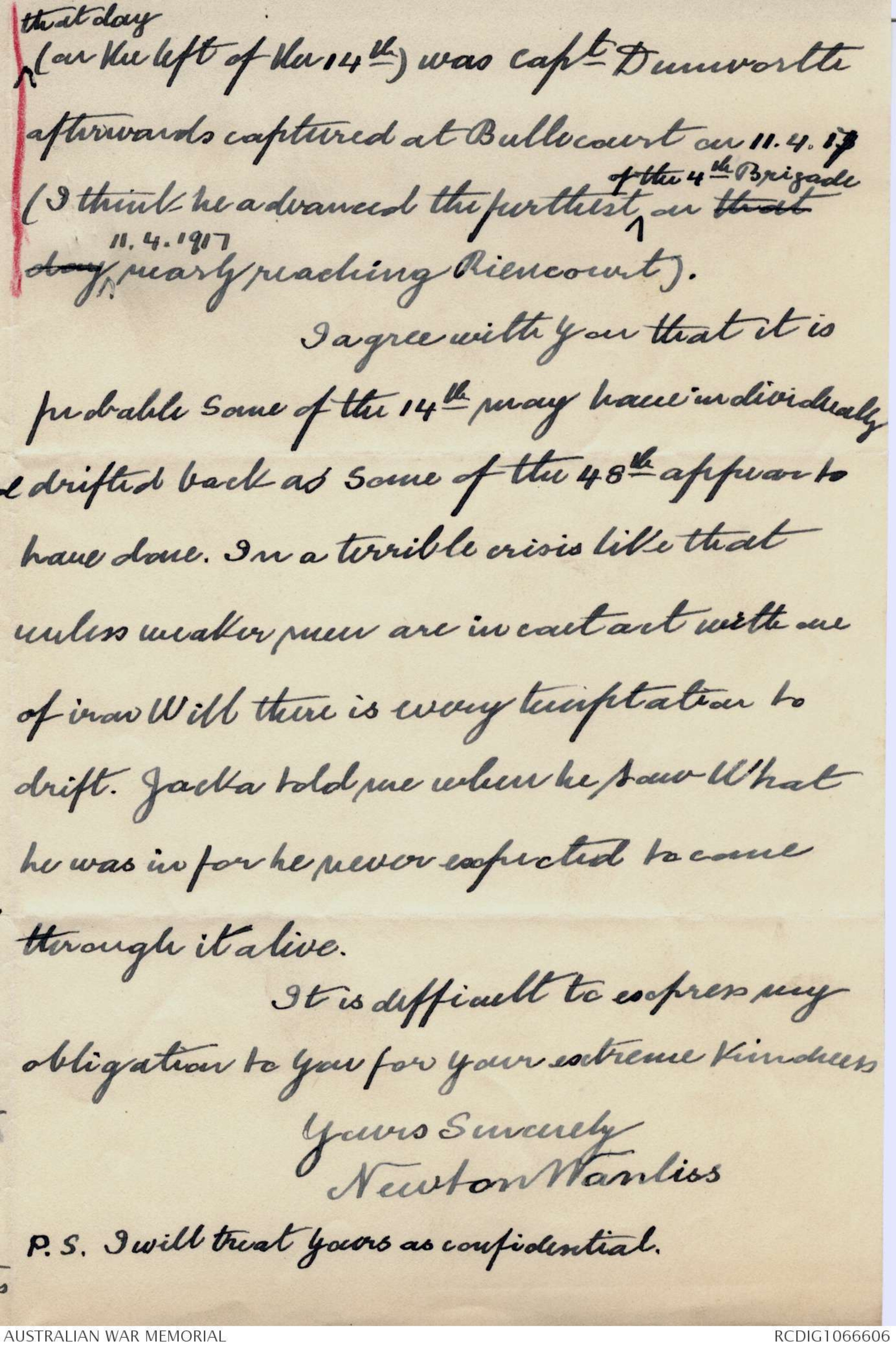
(39
2.
(Contd.)
January 26th. defence a mile out. A report is about that Turks
have been seen not far from the Canal and the
naval police patrol the Canal ready to shoot at
the first people they see between posts.
January 31st. Sections 1 and 4 marched out from camp for the
front. The road runs out some two miles and the
railway about 4. About three miles from the
railhead is Hill 353 and to it marched No. 1
There are several low hills occupied by troops and
we turned off to the left for about 4 miles; the
marching was not bad and we stopped about 10 miles
out from Ferry Post.
The desert is a hopeless waste of endless sand rises,
dotted with stunted leafless bushes and our site is
in a saucer shaped depression on top of out of these
rises. It is occupied by the 17th Infantry from
New South Wales and just as we arrived, an Indian
patrol galloped in to report having exchanged shots
with a Turkish patrol.
February 4th. As a result of visit by General Staff we are to
shift to new site, about 1500 yards nearer to the
front. Our position does not fit in with the
scheme of defence and we spent afternoon in marking
out redoubt at the foot of a steep sand hill to hold
half a battalion of infantry.
February 7th. The sergeant has a redoubt two miles to our rear,
a corporal has our redoubt, and I have trenches,
4 and 5 (sited yesterday) together with their
communication and support trenches to supervise.
Another corporal has a similar group further away,
so that each of us has command of a section of
defence, together with half a dozen sappers to
help supervise and to do the technical work.
February 8th. The trenches are beginning to assume a definite
shape, but the sides are continually falling in,
and what with the shortage of food and the sand
in their eye and ears, the infantry are not very
enthusiastic over the work.
February 14th. Started digging trench No. 5 It is on the same
alignment as No. 4.
The hurdles for revetting are of matting tacked on
wooden frames and are anchored back with wires to
anchors in front of and buried under the parapet.
February 15th. Started support trench to No. 4. It is at the foot
of a steep hill 60 yards behind No. 4 and crossing
the communication trench at right angles, and
consists of an ordinary fire trench with dug out
beneath the parapet and holds 2/3rd of the platoon
allotted to No. 4 trench.
March 15th. Demolition! We are to leave to-morrow for
France and are busy checking stores.
March 17th. We got into Alexandria at 10.15 a.m. after the most
interesting trip I have undergone, and after
skirting L. Alexandria and the back of the city,
pulled up on the wharf.
(40)
3.
1916
March 17th.
(Contd.) Went on board the "Arcadian" at midday, and
left at dusk. Our horses went by another boat
an hour earlier.
(41)
4.
1916.
March 23rd. At 2.30 we marched ashore (Marseilles) and to our
camping place for the night.
April 6th. One of our Cpls. was stopped and interrogated by an
Imperial officer who found it extraordinary that
Australian natives were as white as he was. This
is almost unbelievable but it is a fact.
April 10th In company of our Subaltern and some other N.C.O's
we paid a visit to the trenches. They are three
miles from Eguinghen, and up to within a thousand
yards or so of the firing lines the peasants are
still working their farms. The houses nearer
the lines are badly knocked about and are tenantless.
We entered the trenches from a communication trench
marked "Shaftesbury Avenue", revetted with boards
and hurdles. It is over 1000 yards long and
the level of the late waters is still shown on the
sides. We were shown over our work in the 2nd
support trench, roughly 40 yards from the firing
line. It was much quieter than I had been led
to expect and but for the occasional smack of a
rifle bullet there was nothing very exciting until
just before leaving, when several shells lobbed
about a hundred yards away.
When the company moved out it moved at five minute
intervals per section and we arrived at our billets -
16 huts - opposite a terrace of ten houses. These
houses have for some reason or other up to now not
been touched by shell fire nor has our billet been
touched. It is supposed that in one of them there
are spies and as the terrace is between us and the
enemy we have escaped, their information being of
more value to the Germans than the loss or the two
hundred or so men who might be billetted there.
Anyhow we hope that the billet will have the same
luck while we are here.
April 11th. The company was split up into squads of sappers
under Cpls. who were given sections of the work to
look after. Mine is about 200 yards long, and is,
in parts in pretty bad state.
April 13th. The Australians took over the trenches during the
night and next morning the Germans had "Welcome
Australians" written up on a board. They called
out to them - "Hello Australians, you're going to
take Lille in June aren't you?. They evidently
knew more about our movements than we thought they
did.
April 25th. The "Mad Major" was shelled as usual to-day. He
is a battery Commander who takes his own observations
from an aeroplane and takes great risks from the
German anti-aircraft guns.
May 6th. Last night at 7.45 Germans started terrific bombardment
of our salient and kept it up for nearly two
hours. The noise was terrible and the reports and
explosions were continuous. We could see the
explosions from our billets and also the rockets
that our people and the Germans sent up as signals.
We fell in on the lee side of the terrace and
waited for orders, while the infantry reinforcements,
(42)
5.
1916.
May 6th.
(Contd.) ammunition and stretcher bearers hurried by.
Some of us were sent down to the cottage to unload
our stores at ten o'clock, but were sent up to clean
out a communication trench blocked in the salient.
The wounded were being carried down then from the
dressing station, and one of them was a sapper from
our No. 4 section, who, though he had a dislocated
shoulder, blown off wrist, and six other wounds,
walked down for assistance about a quarter of a mile.
and waited for the worse wounded to be attended to.
We got tools and shifted up into the salient. It
was fairly dark and only one of us knew the road and
he led us wrongly. The parapet was blown to ground
level and while we were crawling along we came on to
a dead man blocking up the trench and had to shift
him - up to our knees in mud. There was another
unfortunate to our right, blown to pieces and we
had to get back to the right road. Machine guns
and flares were fairly busy and we had to crouch
a lot whilst working. Cleared the trench and left
at 3 a.m. for home - wet, muddy and tired. The
day party also had the job of clearing out our
trenches, which were levelled and smashed to pieces.
We had altogether - killed and wounded and the
dead were all over the place - some of them buried
beneath the parapets.
It appears that a party of 50 Germans raided our
trenches after bombardment, armed with bombs,
bludgeons and revolvers, probably with the intention
of making off with one of our Stokes mortars, of
which gun they have not the pattern. About 12
reached the salient but our men killed them.
Nothing stands out better than the conduct of the
wounded, not one of whom complained.
The stretcher bearers and machine gun men worked
splendidly in that hell of fire and one of our men
met the 20th Batt. Q.M. with a bullet in his arm,
carting up rations to the men of the front line.
One of our M.G. men was shot by a sentry for not
answering the challenge. It appears that the
poor fellow had been dazed and deafened by the
continued concussion of the bursting shells.
Rode into Erguinham, and had a hot bath and change
of under clothes this afternoon.
May 8th. The Germans obtained two of our trench mortars the
night of the raid, and also it is believed Lieut.
Blanchardt, who is thought to have gone after them.
These mortars are the first that have been captured
by the Germans and the credit belongs to the 5th
Brigade. It was not the fault of the men, they
died at their posts. The officer in charge of
the mortars had been given instructions not to
leave them in the salient after 5 p.m. and through
his neglect the mortars were captured.
June 3rd. Tramsay Avenue has been extended up to the firing line
and so completes the formation of a strong point that
will be needed if our front line is driven back.
The artillery are receiving shell reserves in large
quantities and everything seems to point to
"something doing" before long.
June 8th. Last night a Sergt. of the 18th, who speaks, German
perfectly, asked a German working party where their
sally port was, and finding a listening post bombed
its occupants and cleared.
(43)
6.
1916.
June 16th. General Birdwood is reported to have offered to
take Lille with the Australians.
August 4th. Work with party on Walkers' Avenue, with 100
infantry as usual, and utilized large shell holes
for R.E. stores and bombs in preparation for the
attach to-night.
Towards dusk hundreds of infantry began to make
their way up Shrapnel Gully, but a Taube above us
noticed them and dropped several signal flares.
As a result the German artillery opened up and
plastered the place with shells. About the same
time we were given a good number of pickets to
split and began to work furiously, for shrapnel
was bursting ahead of us and flying uncomfortably
close. As it grew darker the pandemonium
increased and the sky was filled with reflections
from flares and flashes, and just as we were
finishing a shell burst on the road about 20 feet
away, covering us with dirt; by some miracle
nobody was hit. We all ducked and then worked
like blazes and threw down our tools on finishing,
when we bolted through the smoke to our dugouts,
only just in time.
While we were squatting there, in addition to H.E.
and shrapnel, the Germans sent in a lot of gas shells.
We got our helmets out and just as we finished
examining them a shell came through the rear of our
dugout and burst in the one next to us, where there
were five huddled together. Luckily it was a gas
shell, and only one, Jones, was wounded, and the
others staggered out, gasping and chocking. After
some time we put off our helmets, but put in a
miserable night, the three of us taking it in turn
to do gas picquet. Shells fell around us until
early morning, when we were able to get a little
sleep.
August 21st. Marched out in detachments through La Boroelle Boisselle to
Sausage Gully. Just as we got there our artillery
opened up, and we were in the middle of the heaviest
strafe that I have yet heard. The noise was ear-splitting and Fritz must have had a fearful time
of it. At first I did not recognise Shrapnel Gully,
much grass has grown up there, and the pioneers have
constructed a good road up as far as the chalk pits.
August 22nd. There are dozens of dugouts about, and ours is of
the usual pattern, about 30 feet deep with shelves
to sleep on. The dugouts are splendidly built and
absolutely shell proof. Some of them consist of
long galleries with side off-sets holding bunks and
tables, the centre-way evidently being used for
parades. Inside they are intensely dark and one
can hear very little of the bombardments. Rats
are rather plentiful and scramble over one of a
night, and I have been feeling lice lately.
August 23rd. Our trench (Munster Alley) is running at right
angles from O.G. 1 through the D.O.2, and the
German artillery pounds very near it, but not in
it as they evidently are not sure of its position.
Whenever they shell our front line the German
infantry immediately send up great flares.
7. (44)
1916.
October 31st. Moved off 7.30 to complete semi-circular huts
at Becourt Woods, the other side of Fricourt.
This district is changed in a great degree, and
where we before saw craters, smashed trenches
and levelled houses, is now a vast camp of horses
and men with good roads and railways running
everywhere, loaded with miles of transport
of all descriptions. There were also a great
number of baloons up near where we were working.
Everything and everybody is covered knee deep in
mud and slush. It is the muckiest place I have yet
seen and the roads are flooded with muck of a
porridge like consistency.
November 7th. Late at night we felt several terrific concussions,
accompanied by deafening explosions. We got up to
see great bursts of smoke and flame reddening the
sky, and searchlights and anti air-craft guns
searching for Fritz planes. Guessed that Fritz
had go on to an ammunition dump.
November 8th. To-day it was suggested that the great flares last
night were intended to blind the flash of some of
our big guns.
All last night there was an intense bombardment on
our right - one of the heaviest I have yet heard-
it wounded more like the continuous roll of a drum.
Rain and mud everywhere.
November 9th. Heard that the explosion last night was that of a
bombed French ammunition dump.
November 13th. Carried on with building of huts. Everywhere
we are knee deep in mud and slush.
There is a "tank" near us, stuck in the mud. It
was smaller than I expected to find it - about 8'
high, 30' long and 12 or 15) wide, running on two
elliptical caterpillars. It had two Hotchkiss
6 pdrs. and five M.G.'s on board and the 6 pdrs.
protruded from revolving turrets on either side.
The whole affair had a decidedly naval appearance
and inside it was very compact.
December 25th.
Christmas Day. Where we are the ground is still a sea of great shell
holes and it is a job at night to move about and to
find out the various dugouts.
I wonder what sort of Christmas they are having at
home. Have nothing to read other than "The
Merchant of Venice".
Les. Bull returned from leave last night.
There are three 'tanks' near us; and hundreds of
half and unburied bodies - mostly Germans - lying
about rotting. Delville Wood is near us and is in
a fearfully smashed up state.
Map - see original document
[*HN See
p2*]
Point Lonsdale
12th March 1923
C E W Bean Esq
Historian
Tuggranong
Federal Territory
via Queanbeyan. N.S.W.
Dear Mr Bean
I beg to acknowledge with
many thanks yours of the 9th inst enclosing
your notes of the action of 7th August. Its
perusal has clarified my conception of
the situation. The object of the german
counterattack is difficult to understand
(46)
unless they hoped to throw back our men
& disorganise the attack. The confused
chaotic fighting is almost like a gigantic
football scrimmage.
Sgt Field whom you refer
to lost his leg on the field (no joke intended)
that same day Whilst Appleton was killed
on 8.8.1918 - the last but one of the 14th
officers killed in action.
Jacka always complained
to me that Dobbie lost his nerve & if he
did it is hardly to be wondered at. Jacka
expects men to come up to his own standard.
The line ^on the 7th August appears to have been
weakly held with gaps & the success of
the defence appears to have depended largely
on the nerve & resource of the platoon
commanders.
Among the 15th Battn fighters
(47)
^that day (on the left of the 14th) was Capt Dumvortle
afterwards captured at Bullecourt on 11.4.17
(I think he advanced the furthest ^of the 4th Brigade on that
day ∧ 11.4.1917 nearly reaching Riencourt).
I agree with you that it is
probable some of the 14th may have individually
drifted back as some of the 48th appear to
have done. In a terrible crisis like that
unless weaker men are in contact with one
of iron will there is wary temptation to
drift. Jacka told me when he saw what
he was in for he never expected to come
through it alive.
It is difficult to express my
obligation to you for your extreme kindness
Yours Sincerely
Newton Wanliss
P.S. I will treat yours as confidential.
 Deb Parkinson
Deb ParkinsonThis transcription item is now locked to you for editing. To release the lock either Save your changes or Cancel.
This lock will be automatically released after 60 minutes of inactivity.